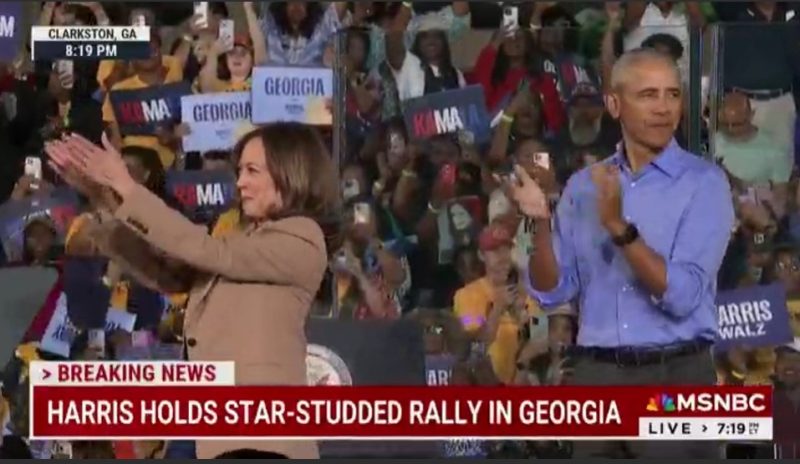
With just nine days left until Election Day, the Kamala Harris campaign has initiated an aggressive barnstorming strategy aimed at maximizing voter turnout and consolidating support in key battleground states.
This final push involves a combination of mass rallies, targeted community engagement, and intensive outreach to secure votes from crucial demographics. The strategy comes as early voting numbers indicate a potential advantage, but both caution and urgency are guiding Harris’s campaign as they enter this decisive phase.
The Barnstorming Effort
The Harris campaign is launching a multi-pronged barnstorming initiative that aims to hit multiple key areas within a short time span. A schedule packed with rallies, town halls, and meet-and-greet events is designed to ensure a direct connection with voters in battleground states like Pennsylvania, Georgia, Arizona, and Wisconsin. The campaign’s focus is not just on large cities but also on suburban and rural areas that could tip the electoral scales in these closely contested states.
In Pennsylvania, for example, Harris herself will be leading a bus tour across multiple counties, focusing on regions that have shown potential to swing. Rural counties that were slightly favorable to Donald Trump in 2020 are now seeing significant campaign efforts, with Harris addressing local issues like healthcare access, agricultural subsidies, and infrastructure development. The idea is to bring a personalized message to these voters, emphasizing that the Harris administration would prioritize often-overlooked communities.
Mobilizing Key Demographics
In Georgia, the campaign is laser-focused on mobilizing African American voters, a key demographic that has historically provided a winning margin for Democrats in the state. The Harris team is partnering with local community leaders, churches, and grassroots organizations to ensure that voters are not only informed but also have the resources they need to cast their ballots early or on Election Day. During a rally in Atlanta, Harris stressed the importance of voter turnout, particularly highlighting the crucial role that young voters and women will play in deciding the outcome.
The campaign has also placed a significant emphasis on reaching out to Latino communities in Arizona. Harris’s recent events included bilingual town halls where she discussed immigration reform, healthcare, and educational opportunities for Hispanic families. The campaign has been quick to respond to polling data that suggests many Latino voters remain undecided; by connecting directly with these communities, Harris hopes to sway voters who may be disillusioned or uncertain about their choices.
Field Operations and Canvassing Blitz
A hallmark of the barnstorming strategy is a massive canvassing blitz that has been organized in conjunction with the Democratic National Committee. Thousands of volunteers have been deployed to knock on doors, distribute flyers, and ensure that voters understand how to navigate the voting process. In Wisconsin, the Harris campaign has focused particularly on Milwaukee and Madison, where voter turnout in predominantly Democratic precincts could determine the state’s electoral outcome. The canvassing efforts are aimed not only at securing votes but also at fighting potential misinformation about voter rights and polling locations.
Campaign insiders have indicated that Harris’s field operation is leveraging advanced data analytics to pinpoint neighborhoods with lower-than-expected voter turnout. By focusing efforts on these areas, they hope to bridge the gap between registered voters and actual turnout. In the past week alone, over 100,000 doors were knocked on in Arizona and Pennsylvania, with the campaign reporting favorable interactions that they believe will lead to a last-minute surge in support.
High-Profile Surrogates and Media Blitz
To complement Harris’s in-person barnstorming, high-profile surrogates have been dispatched across the country to spread the campaign’s message. Former President Barack Obama and several prominent senators have been holding events in states like Michigan and Florida, areas that remain hotly contested. Meanwhile, the Harris campaign has invested heavily in a final media blitz, with ads running on television, radio, and online platforms to target swing voters.
A notable component of the media strategy involves emphasizing Harris’s economic message—the promise of fair wages, healthcare reform, and infrastructure investments aimed at improving lives in communities across America. The ads are tailored to specific audiences, ensuring that key issues resonate with undecided voters. Digital platforms are being used to target younger voters who may not be tuning in to traditional media; these ads focus on social justice, climate action, and student loan relief, issues that polling has shown are critical to younger demographics.
The Stakes and Challenges
While early voting numbers have given the Harris campaign a reason for optimism, campaign officials remain cautious. Political analysts have pointed out that while the Democrats have a strong early vote showing in states like Georgia and Pennsylvania, much will depend on Election Day turnout. Former President Donald Trump is known to perform well among same-day voters, making it critical for the Harris campaign to maintain high energy and keep the momentum going until every last vote is cast.
Additionally, Harris faces the challenge of countering a well-organized GOP effort. Republican operatives have been working to mobilize their base through rallies, phone banks, and targeted ads. Governor Brian Kemp of Georgia, for instance, has thrown his full support behind Trump, leading efforts to expand access to early voting for Republican voters and making personal appearances across key counties.
In the final nine days, Harris’s barnstorming strategy will be an all-out effort to reach voters where they live, addressing the unique concerns of each community and emphasizing what’s at stake in this election. The campaign’s hope is that this direct, on-the-ground engagement will be enough to secure a victory in what has become one of the most closely watched elections in recent history.
